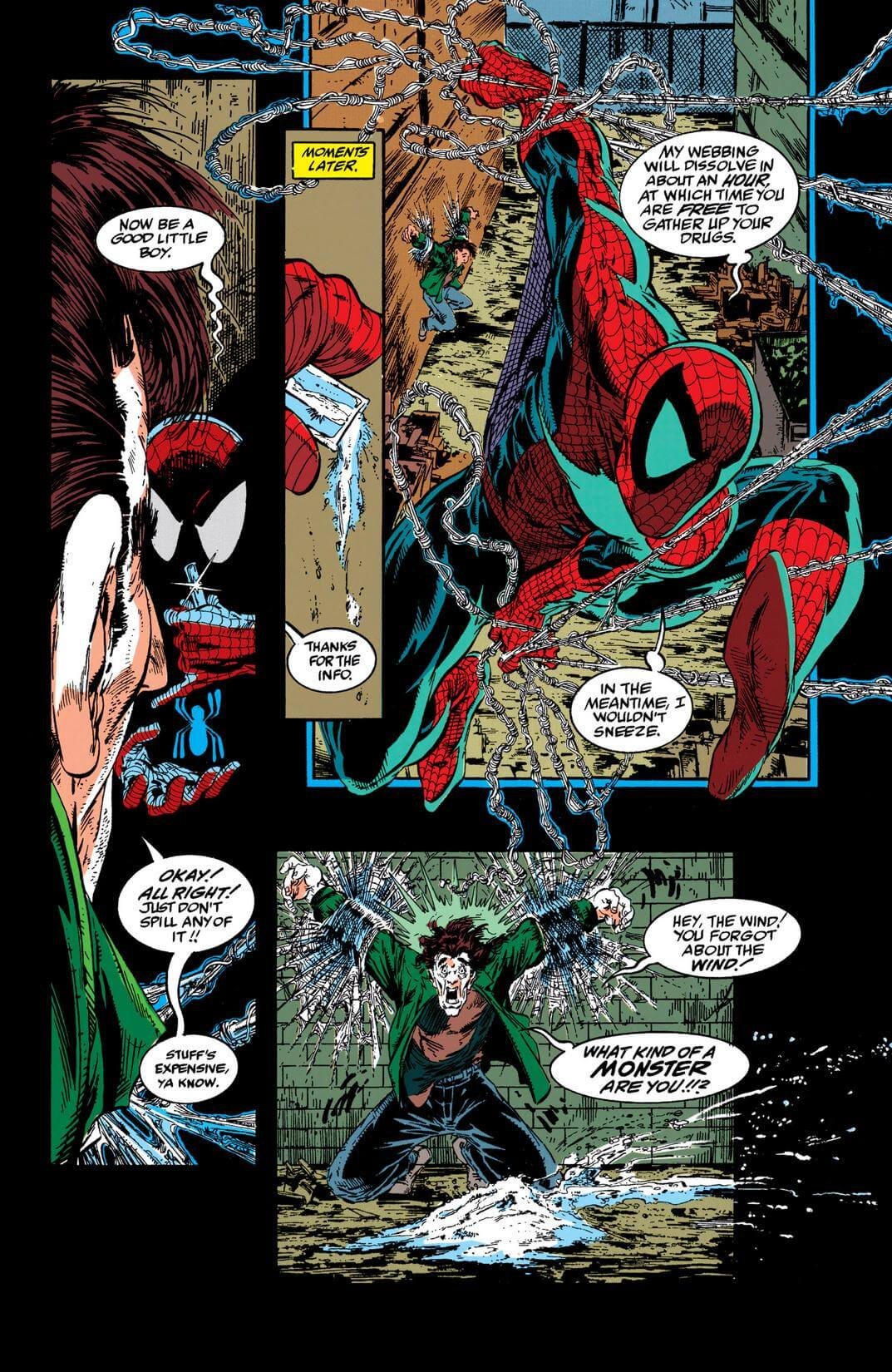Writers: Todd McFarlane, Rob Liefeld, Fabien Nicieza / Pencillers: McFarlane, with Assists by Liefeld / Inkers: McFarlane, Liefeld, Rick Maygar, Scott Williams, Jim Lee / Colour Artists: Bob Sharen, McFarlane, Gregory Wright, Brian Murray / Letterers: Rick Parker, Jim Novak, Chris Elipoulos, McFarlane, Joe Rosen / Editors: Dan Cuddy, Eric Fein, Suzanne Gaffney, Jim Salicrup, Danny Fingeroth, Bob Harras / Collects Spider-Man (1990) #1-#14 & #16, X-Force (1991) #4 / TP / Marvel Comics
28th June 2024 (Released: 10th March 2021)
The Pitch: The book that transformed comics! Todd McFarlane became a superstar illustrating AMAZING SPIDER-MAN, but he changed the industry forever with his next project: the "adjectiveless" SPIDER-MAN! Taking on both writing and art duties, McFarlane ushered Peter Parker into a gritty new era - and it began with "Torment"! When the Big Apple's streets run red with blood, the web-slinger heads into the sewers to stop the Lizard's homicidal rampage. But what is driving his old friend and foe? Plus: Ghost Rider lends a bony hand when the deranged Hobgoblin returns, the wall-crawler finds himself at the center of a clash of claws between Wolverine and Wendigo and Pete goes back in black to face Morbius the Living Vampire! And in the ultimate nineties team-up, Spidey joins X-Force to battle the unstoppable Juggernaut!
Having never really been too much of a Marvel reader until I jumped back onto comics with Kevin Smith’s and Joe Quesada’s Daredevil in the late nineties, McFarlane at Marvel, and then the Image boom, were a mystery to me. I think by and large I’ve decided they’re not for me, so even going back to them now would feel a little redundant. You have to understand, this has nothing to do with not liking McFarlane. It’s more that time out from comics is healthy, even or more especially, for readers. Sometimes you have to accept that you’ll miss out on something. That there’ll always be gaps in your knowledge. It’s something I can live with. Still, never say never, especially when it’s a character you enjoy. So I find myself heading back into this era of Spidey not with trepidation, but curiosity. First of all, you can definitely feel that Image is just around the corner. This almost acts as a bridge between the two phases of comics in the 80s and 90s, the Marvel Era and the Image boom. There's a flash of the 90s edgelord, but that was par for the course for this period. The book feels like a product of its environment. Maybe it's just me, but there seems to be a lot more NYC flavour in the Marvel books of this period than in the stuff you see now.
The first arc is something of an oddity in comics in that offers no clues to the audience as to the identity of Spider-Man's opponent, the strange carribean Witch who has enslaved the lizard and seemingly poisoned Peter. She appears to have no plan beyond kicking ass and taking souls. It also remains unresolved after 5 issues, an interesting choice that speaks to long-term, big-game planning. There's a resonance with what's happening in Big Two comics now as they keep the reader dangling for more than just one trade. Was McFarlane ahead of the game? Yet, this doesn’t get picked up again, not under McFarlane’s tenure anyway. The edgier tone continues with book's second half, as we're reintroduced to a child-kidnapping Hobgoblin and the drop in on the Ghost-Rider giving final judgement to a paedophile.
This more than any other chapter in the book lends itself to the bad boy label that Image comics would later become known for. Issue #6 onwards puts us in the first 'Marvel team-up' phase of the run, with guest appearances by Wolverine and Ghost Rider. A theme begins to solidify, too. Spider-Man is no longer punching colourful Villains and exchanging quips. The journey he's on is a religious one. His enemies now reshaped like demons, the city hell. The awe that children have for Spider-Man can also extend to his Villains, as we see in the Hobgoblin story. It's the awe you might feel for ancient monsters. Spidey clashes with Ghost Rider for punishment of Hobgoblin, the religious smiting of the Spirit of Vengeance versus the more rehabilitative approach of Spider-Man.
'Perceptions', the Wolverine/Wendigo storyline allows more idiosyncracies to creep in. We also get to see Peter being a reporter, which still feels like a rare treat. McFarlane allows touches of Sam Keith into his artwork here. Long sharp curves are abundant. Peter's sense of injustice, usually turned inward on his own life and lot here looks outward as he finds himself in the position of trying to prove the monster innocent. That's part of who he is. Deep down, the optimist hopes the guy he knows hasn't turned bad, hasn't put the Gobin suit back on, hasn't returned to a life of crime. As Spidey wonders about the Bugle's role in stoking the flames of the community's understandable outrage as Children go missing, we're left to wonder if McFarlane is calling out comics and to a certain extent, himself. Just check out this quote from Spidey: "I don't think I’ve ever seen as sick a story as this. Careers, headlines, prestige. My God, are we missing the point? Even worse, do we want to get it? Are sales going to dictate our ethics? So there's a murder? YAHOO! We've read about that before." The exposition is out the window. Instead, McFarlane sits you right in the middle of his character's consciousness. McFarlane writes the villains first as demons, who need followers to embolden them, but who then must come face to face with the fact they are broken Gods, and they may never be fixed.
In the writing, you feel the influence, intentional or not, of J. M. DeMattias' and Mike Zeck's Kaven's Last Hunt, a gothic, simmering madness heading for a fever pitch. There's a kind of dirty poetry in the writing. Speaking of poetry - or at least nursery rhymes - one of the things the spider and Spider-Man represent is the indomitable spirit. After all, Incey Wincey Spider climbed up the water spout more than once. McFarlane is determined to break that spirit, torturing Peter from within and without. A new rhythm takes over his life: Doom, Doom, Doom, and pain, pain, pain. There’s a novelistic feel to all this, something that would become more familiar to readers with the advent of DC’s Vertigo line three years after this made its debut. Yeah, I think McFarlane was definitely ahead of the game. As we go deeper into the story, more proto-Vertigo references seem to appear. Close-ups of flies, single-word captions in the panels... It all has the lingering touch of what would become Karen Berger's taste for novelistic intellectualism. Even Wolverine starts to resemble a creature from Sandman's version of hell. Whether you like it or not, McFarlane was certainly making bold artistic choices here. There is in a way, partly satire to be found. Mcfarlane embraces the bad boy, tough-as-nails attitude in everyone but Spidey himself, making Peter the moral beacon. But in Perceptions, you get the sense that Mcfarlane's heart truly lies with Wolverine. Mcfarlane's characters feel sexed-up, or at least as sexed up as they could be ostensibly still operating under the Comics Code Authority. Peter has to go 'Back in Black', much to MJ's chagrin, in order to investigate kidnapped bums in the sewers. The book is very much a tour around the 'A minus' level of villains. We get Hobgoblin, Morbius... Coupled with McFarlane writing like an educated conspiracy theorist, with creatures coming up from the sewers. You get the sense that McFarlane is closing the book on his association with Ol’Web-Head. None of this is to say the book is without lightness, especially in the scenes with MJ, which the fans doubtless cherished. It remains the emotional core of the book.
In the art, there are traces of Bernie Wrightson's faces, particularly in the criminals of Spidey's New York. They could be painted on the walls of baroque houses. The array of inkers on the book, Liefeld, Rick Maygar, Scott Williams, and Jim Lee are all artistic talents in their own right who would go on to have major or at the very least notable careers. And they make McFarlane’s art better, richer. It’s art that doesn’t want to be contained within the panels and often isn’t. Like an arachnid, it crawls across the page. There’s something of Frank Miller’s pugilistic, fungal look to the faces. You feel like it’s New York before it got clean. The panels feel huge. I wonder what size board McFarlane was using on this. It feels like the size the artists who draw Black Label books would use. The colourists, Bob Sharen, McFarlane, Gregory Wright, and Brian Murray all add horrific luridness to the panels that help jam them into your brain. The letterers, Rick Parker, Jim Novak, Chris Elipoulos, and Joe Rosen give a distinct sound to the guttural creatures that inhabit McFarlane’s gothic hellscape. This Spider-Man is an enticing, atmospheric read that I’m sorry I missed the first time around. God only knows what I would have thought of it back then!
Check your local comic shop for copies of Spider-Man by Todd McFarlane Complete Collection (TP).







